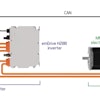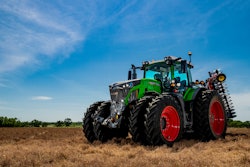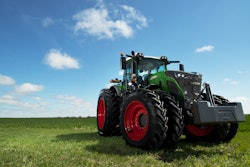
AGCO Corp. has unveiled the latest generation of its Fendt 900 Series tractor which can be used for a wide range of agricultural applications, but was specifically designed to meet the needs of the North American row crop market. According to Andrew Sunderman, Tactical Marketing Manager, High Horsepower Tractors at AGCO, the tractor features expanded technology offerings and is designed to meet the needs of changing agricultural practices.
It will be offered in five models ranging from 296-415 hp (220.7-309.5 kW) engine horsepower. For the 900 Series AGCO has chosen to utilize MAN 6-cylinder, 9.0 L engines, enabling it to employ a low engine speed concept first introduced with the company’s 1000 Series tractors. Working in tandem with the Fendt tractor management system (TMS) and stepless VarioDrive continuously variable transmission (CVT), the low engine speed concept enables the engine to operate at a maximum speed of 1,700 rpm and an idle speed of 650 rpm. “This allows for better fuel efficiency and reduced wear on the engine without compromising pulling performance,” says Sunderman.
The tractor’s CVT powers both the front and rear axles independently. By doing so the right amount of power is provided to each axle based on the application requirements. “We have an intelligent way of connecting the two axles together to make sure that you remain pulling in all aspects of the field, particularly when one axle begins to slip,” says Sunderman. “This is technology that's commonly found on high-performance luxury vehicles and has been incorporated directly in to a high-performing tractor.”
Optimal tire and axle configurations
AGCO has designed the tire setup of the Fendt 900 to meet the needs of North American row crop applications. It is available with row crop tires in a dual configuration, featuring 60 in. (152.4 cm) centers and 120 in. (304.8 cm) on the outer rows to suit larger corn belt tractors, particularly those in the Midwest, explains Sunderman. In addition to narrower corn segments, the tractor has the ability to operate in wider row crop settings such as those for potatoes and sugar beets.
Included on the 900 Series is the Fendt VarioGrip central tire inflation system which allows operators to change tire pressure as necessary from the cab simply by pushing a button. “It allows us to tailor the tire pressure to the implement [or application] and get a more even distribution of weight across the soil, providing less compaction,” says Sunderman. 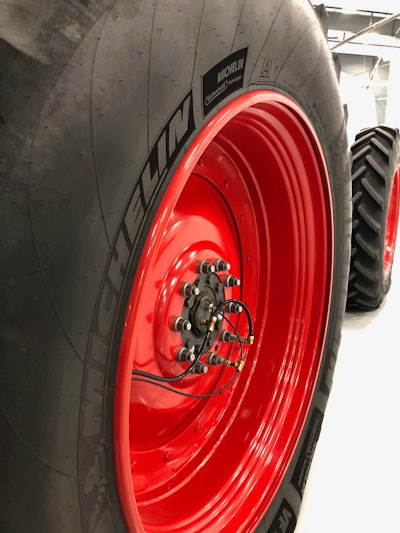 The VarioGrip tire inflation system allows operators to quickly inflate and deflate tires as necessary with the push of a button in the cab.S. Jensen
The VarioGrip tire inflation system allows operators to quickly inflate and deflate tires as necessary with the push of a button in the cab.S. Jensen
He says this is the first time Fendt has made the technology available on row crop tires, and in a setup with eight tires in a dual configuration. The system can increase tire pressure by 1 bar (14.5 psi) within about 30 seconds, helping speed the transition between field and roadway travel for operators. The Fendt 900 has a maximum road speed of 31 mph (49.9 kph).
VarioGrip is available on many of the tire options and configurations available for the 900 including single and wide tires.
The Fendt 900 also includes a double wishbone front axle suspension to aid both comfort and performance. With this axle design approximately 8 in. (20.3 cm) of travel can be achieved, allowing the front wheels to remain in a more parallels movement to the hood, explains Sunderman. “This allows us to keep the widest, flattest part of the tire pinned to the ground for better soil contact, giving us better pulling performance, [and] reducing ground compaction by spreading that over a wider area.”
In addition, tire wear is reduced because all of the vehicle weight is not put onto individual parts of the tire.
Sunderman says the front axle suspension is also the first point in which some of the unevenness encountered in the fields is removed and prevented from reaching the operator to ensure a comfortable ride.
Improved comfort and visibility
Ensuring an optimal operator experience was a major factor when designing the Fendt 900’s cab. There is additional glass on this tractor compared to previous versions to ensure visibility, as well as refined styling, says Sunderman. The cab also includes the multifunction armrest found in all Fendt tractors—providing commonality for those operators who may move from machine to machine.
Included on the armrest is the Fendt Profi joystick, a multifunction device which puts all key controls at the operator’s fingertips. Buttons on the joystick and remainder of the armrest are color coded to ease the learning curve for machine functions. For instance, buttons that are orange are those which control transmission function while blue buttons are for the hydraulics. The company says colors are universal, eliminating language barriers that might otherwise be an issue when learning machine functions. 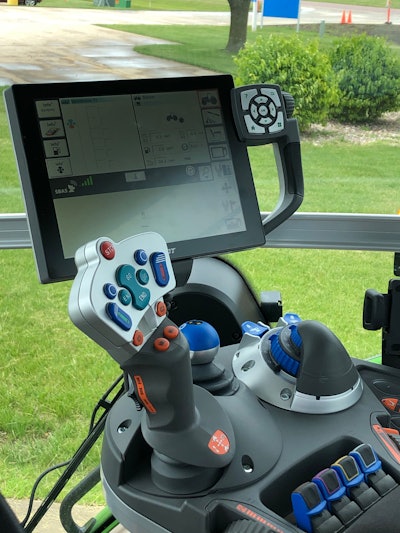 The armrest includes Fendt's Profi joystick, a multifunction device which puts all key controls at the operator’s fingertips.S. Jensen
The armrest includes Fendt's Profi joystick, a multifunction device which puts all key controls at the operator’s fingertips.S. Jensen
Integrated into the armrest is also Fendt’s 10.4 in. (26.4 cm) touchscreen VarioTerminal on which operators can see all tractor settings and make adjustments as needed. The display also provides information on implement control, guidance, cameras and more, all on a single device. Additional monitors can be added if an operator chooses. AGCO says it finds customers are split between those that want all of their machine functions on a single display and those who prefer to have multiple displays; because of this, rails are incorporated into the cab onto which additional displays can be mounted.
Sunderman says there are three cab suspension options available to meet customers’ comfort needs. Standard on the tractor is a two-point pneumatic air suspended cab with two pneumatic cab suspension points at the back of the vehicle. For those customers looking for a lower price option, he says a two-point mechanical cab suspension is available.
And for customers wanting the highest level of comfort, a three-point pneumatic cab suspension with two points at the rear and one at the front is available. This cab is especially beneficial for customers doing more road driving or who spend a lot of time in the tractor cab throughout the year.
Pneumatic systems are used throughout the tractor not only for the cab suspension but also in the seat options available—to further ensure comfort—and the brakes; Sunderman says the air brakes provide more reliable stopping time after time while the dual line air trailer brakes ensure better operation of the larger implements the tractor may tow.
Having an air system directly integrated into the infrastructure of the tractor enables the inclusion of the VarioGrip system, as well as placement of the air compressor for the air ride seat outside of the cab to provide a quieter operator environment.
The design of the tractor’s front end is integral to the improved visibility it offers. Sightlines are designed to provide 360-degree visibility around the tractor. Sunderman says the hood was narrowed to allow better visibility as well as improved maneuverability in tight spaces and when turning with smaller implements. With the narrower hood, operators can better see the front of the tractor including the tires.
Also aiding visibility is the inclusion of a camera at the front of the tractor. Video from it is displayed onto the VarioTerminal. “It really plays a benefit when you're connecting either weights or front implements, [and] also provides a much easier way to maneuver through some of those tight spaces—whether it's barns or in the yard—to make sure there is clear visibility in all areas in front of the tractor,” says Sunderman.
Windshield wiper placement was also taken into consideration and hidden behind the engine compartment to completely remove it from view and not hinder visibility.
A full LED lighting package is included on the Fendt 900, offering 66,000 lumens for improved visibility even at night. Telescoping mirrors were also integrated onto the tractor which allow operators to electronically adjust the width of the mirrors as well as the mirror panes. This feature is easy to control from the operator display and makes sure farmers have the best visibility to the back of the tractor, says Sunderman.
Egress has been improved, as well, by slightly sloping the stairs for easier and safer entry and exit. “This can be felt primarily by those operators that have to get on and off multiple times throughout the day,” says Sunderman.
 The Fendt 900 has a road speed of 31 mph (49.9 kph).AGCO Corp.
The Fendt 900 has a road speed of 31 mph (49.9 kph).AGCO Corp.
Connections to meet a range of applications
At the front of the tractor are several implement connection points. Sunderman says this is to enhance its utilization for farmers, and enables the Fendt 900 to complete several types of jobs with a single machine that would have required multiple tractors in the past. Implements which can be attached include triple mowers, snow blowers, front blades and a variety of others.
A front PTO is available for the tractor, as well, further adding to the applications in which it can be used.
On the rear of the tractor is an implement setup similar to the company’s fifth generation 1000 Series tractor which provides customers a configurable valve setup. Three hydraulic options are available on the 900 Series, the base option being a 58 gpm (219.5 lpm), single pump hydraulic system. There is also an optional 43 gpm (162.8 lpm) system for operators who don’t require as much capacity. For operations using larger implements—such as planters—a dual pump dual circuit 113 gpm (427.8 lpm) hydraulic system is available, as well. According to Sunderman, it provides flow to the largest and most demanding implements currently in the industry and those expected to be available in the future.
With this setup, the tractor is capable of meeting a variety of customer needs.
AGCO plans to debut the tractor to the agricultural industry at this year’s Farm Progress Show taking place in Decatur, IL.



